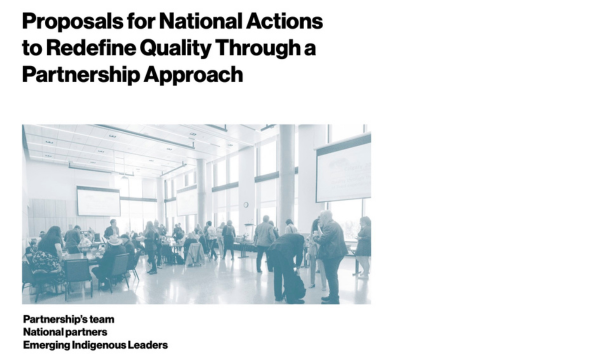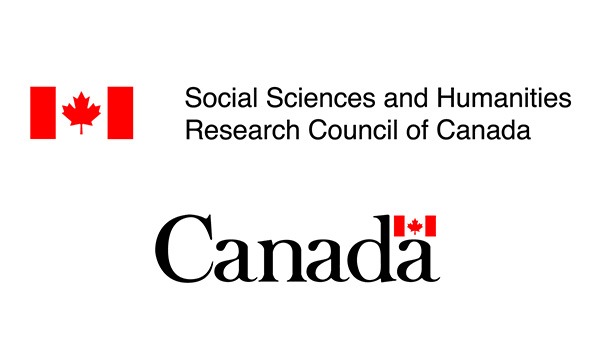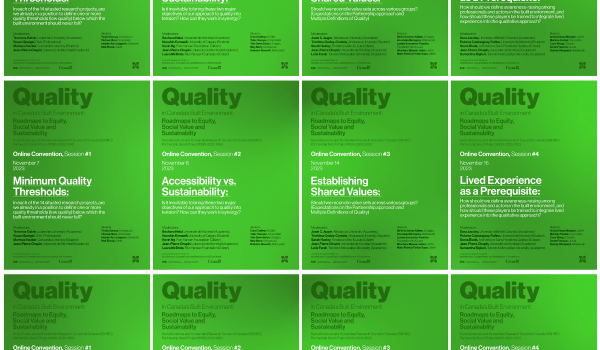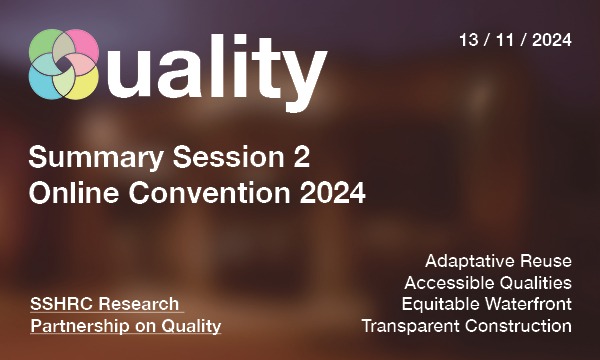This final session of the 2024 online convention featured presentations from three research sites, focusing on the themes of Livable Nightscapes, Reconciled Land, and Quality Principles and Processes. National partners provided thoughtful feedback, emphasizing collaboration, inclusivity, and shared learning to advance the initiative’s goals. This session concluded the convention by reflecting on accessibility and quality in Canada’s built environment.
*Please note that the following summary was created with the help of an AI tool (fireflies.ai).
Summary;
🏙️ Project Overview and Presentations (00:00 – 14:15) (00:00 – 14:15)
Jean-Pierre Chupin introduces the midterm point of a five-year journey on Canada’s built environment
- This event marks the midterm evaluation of a five-year initiative focused on improving Canada’s built environment.
- The project involves multiple cities, having started in Montreal, moved to Calgary, and then Halifax, with Toronto as the next meeting point.
- The goal is to develop actionable recommendations related to quality in the built environment, addressing short, medium, and long-term issues.
Three subjects to be covered: Livable Nightscapes, Reconciled Land, and Participatory Processes
- Livable Nightscapes focus on creating inclusive and vibrant urban environments that cater to diverse communities during nighttime, addressing issues such as safety, accessibility, and cultural expression.
- Reconciled Land emphasizes the need for equitable access to parks and public spaces, examining historical injustices and advocating for inclusive design that reflects the needs of marginalized communities.
- Participatory Processes highlight the importance of engaging local stakeholders in decision-making, ensuring that diverse voices are heard and incorporated into urban planning and design initiatives.
National partners to share their views on the presentations
- National partners expressed appreciation for the presentations and the collaborative efforts of the teams.
- They emphasized the importance of identifying barriers to achieving quality in built environments and the need for effective communication of these challenges.
- There was a call for integrating lessons learned from various projects to create a more universal approach to quality standards in architecture and urban planning.
Ipek Türeli presents on Livable Nightscapes, focusing on Montreal’s nightlife policy and the broader concept of the 24-hour city
- Montreal’s nightlife policy aims to promote harmonious cohabitation between nightlife venues and residents, addressing issues like noise management and safety.
- The project explores the concept of the “right to the city,” emphasizing the importance of access to diverse urban subcultures and the role of marginalized communities in shaping nightlife experiences.
- The research seeks to develop pedagogical tools for architects and urban designers to integrate the significance of time and nocturnal activities into urban planning, enhancing the overall quality of the built environment.
Research team explores the role of time and chrono-rhythm in urban experience
- The research team investigates how different timeframes influence urban life and community interactions.
- They analyze the impact of nightlife on marginalized groups, emphasizing the importance of safe spaces for socialization and community building.
- The study aims to integrate time as a critical factor in urban design and policy-making to enhance the overall quality of urban environments.
🌙 Nightlife Research and Methodology (14:23 – 19:57) (14:23 – 19:57)
Iris Pintiuta discusses the methodology for understanding nighttime city inhabitants
- Iris Pintiuta emphasizes the importance of engaging with marginalized communities to understand their experiences in the nighttime city.
- The methodology includes conducting night walks, film screenings, and ideation workshops to gather insights from various inhabitants, such as the unhoused and queer communities.
- Collaboration with stakeholders who have intimate knowledge of the changing urban landscape is crucial for identifying needs and supporting vulnerable populations.
Research includes night walks, film screenings, and ideation workshops
- Research methods aim to engage diverse communities in understanding nighttime urban experiences.
- Night walks allow participants to explore and document their interactions with the city after dark.
- Film screenings and ideation workshops facilitate discussions on the role of nightlife in community building and social sustainability.
Focus on marginalized communities and their needs in the nighttime city
- Understanding the unique challenges faced by marginalized communities during nighttime, including issues related to safety, accessibility, and visibility.
- The importance of creating inclusive spaces that cater to the needs of diverse groups, such as the LGBTQ+ community and individuals experiencing homelessness, to foster community building and social sustainability.
- Encouraging policymakers and urban designers to consider the concept of “the right to the city” to ensure equitable access to nighttime activities and resources for all residents.
Development of a nightcare network to provide resources and information
- The nightcare network aims to connect marginalized communities with essential resources and support services available during nighttime hours.
- It includes initiatives such as providing safe spaces, access to basic needs like food and shelter, and promoting community engagement through events and workshops.
- The network seeks to address the unique challenges faced by individuals who inhabit the night, including those experiencing homelessness and members of the LGBTQ+ community, by fostering inclusivity and accessibility.
Specific research on queer nightlife and lesbian bars
- Research focuses on the unique social and cultural roles that lesbian bars play in community building and support for LGBTQ+ individuals.
- Studies examine the challenges faced by newly opened lesbian bars, including misalignment between community needs and business offerings, which can lead to temporary closures.
- The research aims to create actionable recommendations for enhancing the sustainability and inclusivity of queer nightlife spaces, ensuring they meet the diverse needs of their communities.
🏞️ Reconciled Land Project (20:06 – 29:46) (20:06 – 29:46)
Kees Lokman introduces the Reconciled Land project, focusing on parks, land use, and social equity
- Kees Lokman highlights the need to address historical and present-day injustices in park creation and distribution.
- The project aims to develop equitable planning and design approaches by examining governance and decision-making processes in park development.
- Community engagement is emphasized, with a focus on involving diverse stakeholders to ensure parks meet the needs of all community members.
Project aims to address historical and present-day injustices in park creation and distribution
- The project seeks to identify and rectify inequities in the establishment and design of parks.
- It emphasizes the need for parks to serve not only recreational purposes but also broader community priorities, including accessibility and safety.
- The initiative aims to engage diverse community perspectives to ensure that marginalized voices are included in the planning and decision-making processes.
Three main components: spatial and temporal distribution, governance and decision making, and social spatial dynamics
- Spatial and temporal distribution examines how parks and public spaces are allocated and utilized over time, considering factors like accessibility and community needs.
- Governance and decision making focuses on the roles and influences of various stakeholders in the planning and development of public spaces, aiming for more inclusive and equitable processes.
- Social spatial dynamics explores the interactions between communities and their environments, emphasizing the importance of understanding diverse perspectives and experiences in shaping public spaces.
Crab Park used as a central focus for studying public space complexities
- Crab Park serves as a case study for understanding the complexities of public space in urban settings.
- The park is home to Canada’s first legal encampment, highlighting the challenges of inclusivity and accessibility in public spaces.
- Research focuses on the historical role of Crab Park and its significance for marginalized communities, emphasizing the need for parks to address broader community priorities beyond recreational use.
- Engagement with local stakeholders, including residents and community organizations, is essential for developing equitable governance and decision-making processes related to park design and management.
Studio course examining the role of landscape architecture in creating inclusive parks
- Focus on designing parks that prioritize accessibility and inclusivity for all community members, including marginalized groups.
- Engage students in hands-on projects that analyze existing park spaces and propose design solutions to enhance social equity and environmental sustainability.
- Collaborate with local organizations and stakeholders to ensure that community needs and voices are integrated into the park design process.
Sarah Jacobs discusses the spatial and temporal distribution component of the project
- The spatial and temporal distribution component examines how parks in Vancouver have developed over time.
- The research aims to develop decision-making tools for planners and designers focused on equity and access to nature.
- The project analyzes the histories of over 160 parks, revealing connections between socioeconomic development and park creation.
Analysis of over 160 parks in Vancouver, examining their histories and development
- Analysis of over 160 parks in Vancouver focuses on:
- Understanding the historical context of park development, including the socio-economic factors that influenced their creation and redesign.
- Identifying patterns of inequity in park distribution and access, particularly in relation to marginalized communities and their needs.
- Utilizing visual representation and mapping to illustrate the relationships between park locations, urban development, and community engagement over time.
Visual representation used as primary research method
- Visual representation serves as a powerful tool for analyzing complex data and relationships within urban environments.
- It enables researchers to communicate findings effectively, making abstract concepts more accessible to diverse audiences.
- Visual tools can facilitate collaborative discussions among stakeholders, enhancing engagement and fostering a shared understanding of urban design challenges.
Findings show parallels between socioeconomic development plans and park creation
- Findings indicate that parks are often established in areas deemed economically undesirable, reflecting broader socioeconomic trends.
- The creation of parks frequently aligns with urban development initiatives, prioritizing economic gain over community needs.
- Historical patterns reveal that marginalized communities may be disproportionately affected by park placement and design decisions.
Timeline trends in park establishment and redevelopment visualized
- The analysis of over 160 parks in Vancouver reveals historical patterns of park creation often linked to colonial and economic developments rather than community needs.
- Visual representations of park establishment and redevelopment timelines help identify correlations between urban development plans and the allocation of public green spaces.
- Mapping tools can illustrate the impact of socio-economic factors on park locations, highlighting areas of inequity and informing future planning decisions.
🔍 Quality Principles and Processes (40:31 – 52:01) (40:31 – 52:01)
Michel de Blois presents on defining and capturing quality principles in architecture
- The project focuses on developing a dictionary and syntax for connecting composite principles of quality to geo-data via a collaborative platform.
- It aims to understand the underlying causes of quality-related problems in architecture by analyzing different perspectives from various stakeholders.
- The initiative seeks to create tools that facilitate effective communication and decision-making regarding quality principles in urban planning and architecture.
Development of a dictionary and syntax for connecting composite principles to data
- The project aims to create a comprehensive dictionary that defines quality principles in architecture and urban design.
- It will establish a syntax to connect these principles to geospatial data, facilitating better understanding and communication among stakeholders.
- The goal is to enhance decision-making processes by providing a structured framework for interpreting and applying quality principles in various contexts.
Focus on understanding root cause mechanisms of problems in architecture
- Understanding root cause mechanisms of problems in architecture involves:
- Identifying underlying factors that contribute to design failures, such as socio-economic influences, regulatory constraints, and cultural contexts.
- Utilizing interdisciplinary approaches to analyze how various elements, including stakeholder perspectives and environmental conditions, interact and affect architectural outcomes.
- Implementing feedback loops in design processes to continuously assess and adapt solutions based on real-world impacts and community needs.
Collaboration with the city of Quebec to implement findings in urban planning processes
- Collaboration with the city of Quebec aims to integrate research findings into urban planning frameworks to enhance quality standards in public spaces.
- The partnership focuses on identifying barriers to effective urban design and developing strategies to overcome these challenges through community engagement and stakeholder involvement.
- Ongoing efforts include creating a collaborative decision-making tool that utilizes geo-data to inform planning processes and ensure that diverse community needs are addressed in urban development.
Development of tools for capturing and translating quality principles
- The creation of a collaborative decision-making tool that allows stakeholders to visualize and project quality principles onto geographic maps, facilitating better planning and decision-making.
- The development of a comprehensive vocabulary and syntax for quality principles, enabling effective communication among diverse actors in the built environment.
- Integration of qualitative and quantitative data from various sources to create a geo-referenced database that tracks and evaluates the impact of quality principles on community well-being.
Discussion of GIS tools and databases for visualizing quality principles
- The project utilizes GIS tools to visualize and analyze the spatial distribution of quality principles in urban environments.
- Data is sourced from over 60 different databases, incorporating both qualitative and quantitative information to enhance decision-making processes.
- The development of an interactive mapping platform aims to facilitate stakeholder engagement by allowing users to visualize how various quality principles intersect with urban features.
Development of a collaborative decision-making tool
- The collaborative decision-making tool aims to enhance stakeholder engagement in urban planning processes.
- It facilitates the visualization of quality principles and their interrelations with various urban elements, aiding in informed decision-making.
- The tool is designed to track the evolution of quality principles over time, ensuring transparency and accountability among stakeholders.
Integration of qualitative and quantitative data in mapping
- Integration of qualitative and quantitative data enhances the accuracy and depth of mapping by combining numerical data with contextual insights.
- This approach allows for a more comprehensive understanding of spatial dynamics, as it captures both measurable attributes and the lived experiences of communities.
- Utilizing diverse data sources fosters inclusive decision-making processes, ensuring that various stakeholder perspectives are represented in urban planning and design.
Plans to create a geo-referenced database and interactive mapping platform
- Enhance decision-making by allowing users to visualize and analyze spatial data related to quality principles in urban planning.
- Facilitate collaboration among stakeholders by providing a shared tool for tracking and assessing the impact of various quality initiatives across different projects.
- Support the integration of qualitative and quantitative data, enabling a comprehensive understanding of community needs and environmental factors in the design process.
Emphasis on connecting actors’ visions of quality to geomapping tools
- Connecting actors’ visions of quality to geomapping tools can enhance collaborative urban planning by:
- Facilitating the visualization of diverse stakeholder perspectives, allowing for a more comprehensive understanding of community needs and preferences.
- Enabling real-time data analysis and feedback, which can inform decision-making processes and improve the responsiveness of urban development initiatives.
- Creating a shared platform for communication among various actors, fostering transparency and trust in the planning process while addressing potential conflicts and aligning priorities.
💼 National Partners’ Feedback (57:52 – 01:07:30) (57:52 – 01:07:30)
Christopher Dziwinski from PSPC emphasizes the importance of identifying barriers to quality
- Identifying barriers is crucial for understanding why projects may not achieve the desired quality standards.
- Effective communication of the risks associated with not meeting quality standards can help gain traction with decision-makers.
- Linking quality objectives to existing priorities can enhance the likelihood of achieving desired outcomes in projects.
Suggestion to link quality objectives to existing priorities for better traction
- Identify and articulate how quality objectives can address current challenges or gaps in existing policies to enhance relevance and urgency.
- Leverage existing frameworks and initiatives to align quality objectives with broader community goals, ensuring they resonate with stakeholders’ priorities.
- Communicate the potential risks of neglecting quality objectives to decision-makers, emphasizing the long-term benefits of prioritizing quality in urban planning and development.
Susan Spiegel discusses the importance of naming and focusing projects
- Naming projects effectively can enhance clarity and engagement, helping to communicate their purpose and goals succinctly.
- A concise and impactful name can facilitate understanding among diverse audiences, making it easier to convey the project’s significance and desired outcomes.
- Iterative naming processes can lead to deeper connections with the project’s objectives and foster collaboration among stakeholders by aligning their visions and expectations.
Recommendation for cross-pollination between different project sites
- Encourage collaboration between project teams to share insights and best practices, fostering a culture of learning and innovation across different sites.
- Establish regular communication channels, such as workshops or online forums, to facilitate the exchange of ideas and experiences among diverse stakeholders involved in various projects.
- Utilize a centralized platform to document and disseminate lessons learned, ensuring that successful strategies and challenges faced by one project can inform and enhance the efforts of others.
Emphasis on the need for concise, action-oriented project names
- Emphasizing concise project names can enhance clarity and engagement.
- Action-oriented names can effectively communicate the project’s goals and outcomes.
- Shorter names facilitate easier recall and promote broader understanding among diverse audiences.
Doramy Ehling emphasizes the importance of accessibility in design
- Doramy Ehling highlights the need for design to prioritize accessibility to ensure inclusivity for all community members.
- She emphasizes the importance of integrating accessibility into the curriculum for future architects and planners.
- Ehling calls for collaboration among stakeholders to create a design culture that actively addresses accessibility challenges.
Call for changes in design culture and curriculum to address accessibility
- Encouraging educational institutions to integrate accessibility principles into architecture and design curricula to prepare future professionals for inclusive practices.
- Promoting interdisciplinary collaboration among architects, planners, and community stakeholders to ensure diverse perspectives are included in the design process.
- Advocating for the development of practical tools and resources that facilitate the implementation of accessibility standards in urban planning and built environments.
Jonathan Bisson discusses community engagement success and challenges
- Community engagement has led to active participation from local stakeholders in policy development.
- Challenges include aligning recommendations with existing municipal and federal frameworks, which often have divergent priorities.
- There is a need for intensified awareness efforts to foster a broader understanding of accessibility and spatial justice issues.
Emphasis on aligning recommendations with existing municipal and federal frameworks
- Ensuring that recommendations are compatible with current municipal and federal policies can enhance the likelihood of successful implementation.
- Engaging stakeholders early in the process helps identify potential conflicts between short-term costs and long-term sustainability goals.
- Regular monitoring and adjustment of recommendations in line with existing frameworks can foster transparency and accountability, building trust among stakeholders.
Plans for exhibiting work at the RAIC annual meeting in Montreal
- A dedicated series of rooms will be allocated for showcasing the various roadmaps and projects developed throughout the research partnership.
- The exhibition aims to highlight the collective efforts and insights gained from the projects, emphasizing the importance of quality in the built environment.
- Engagement with attendees will be encouraged to foster discussions on the challenges and successes of the projects, promoting a broader understanding of the issues addressed.



